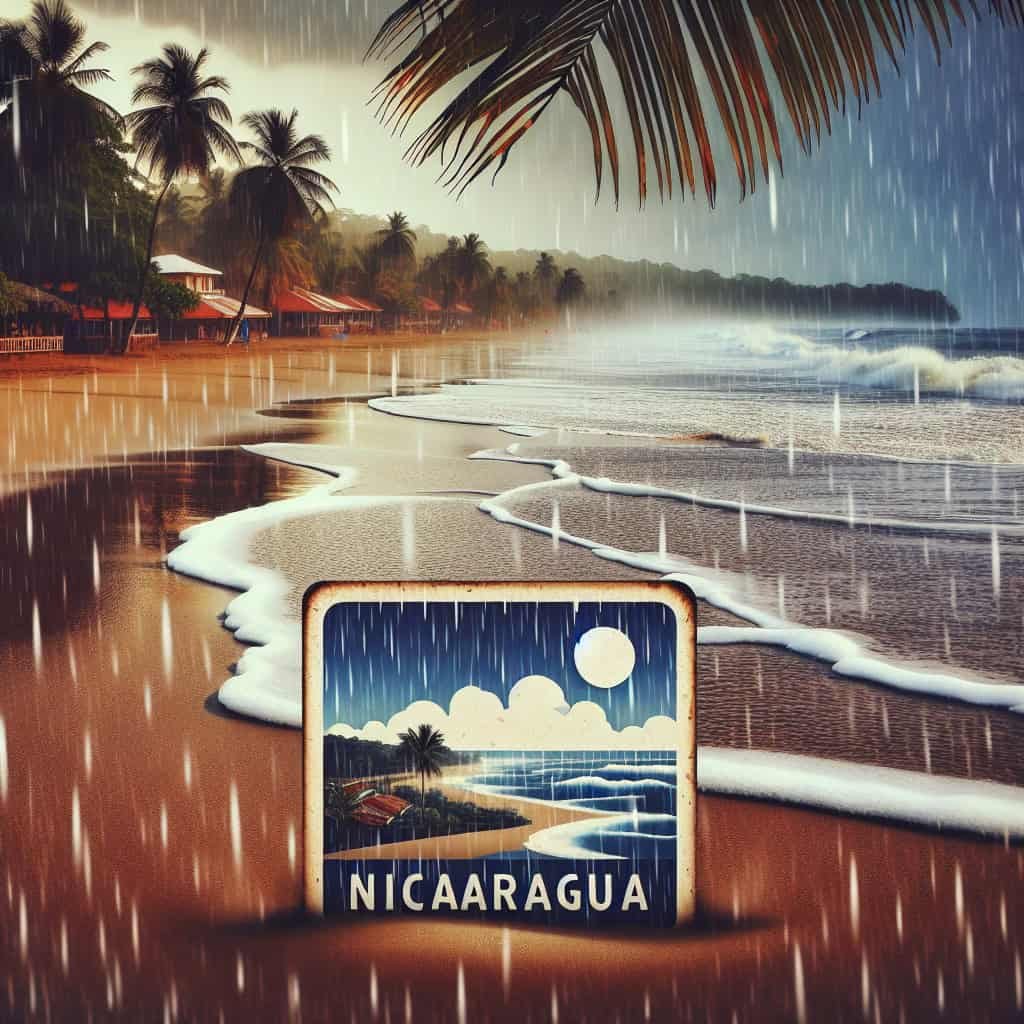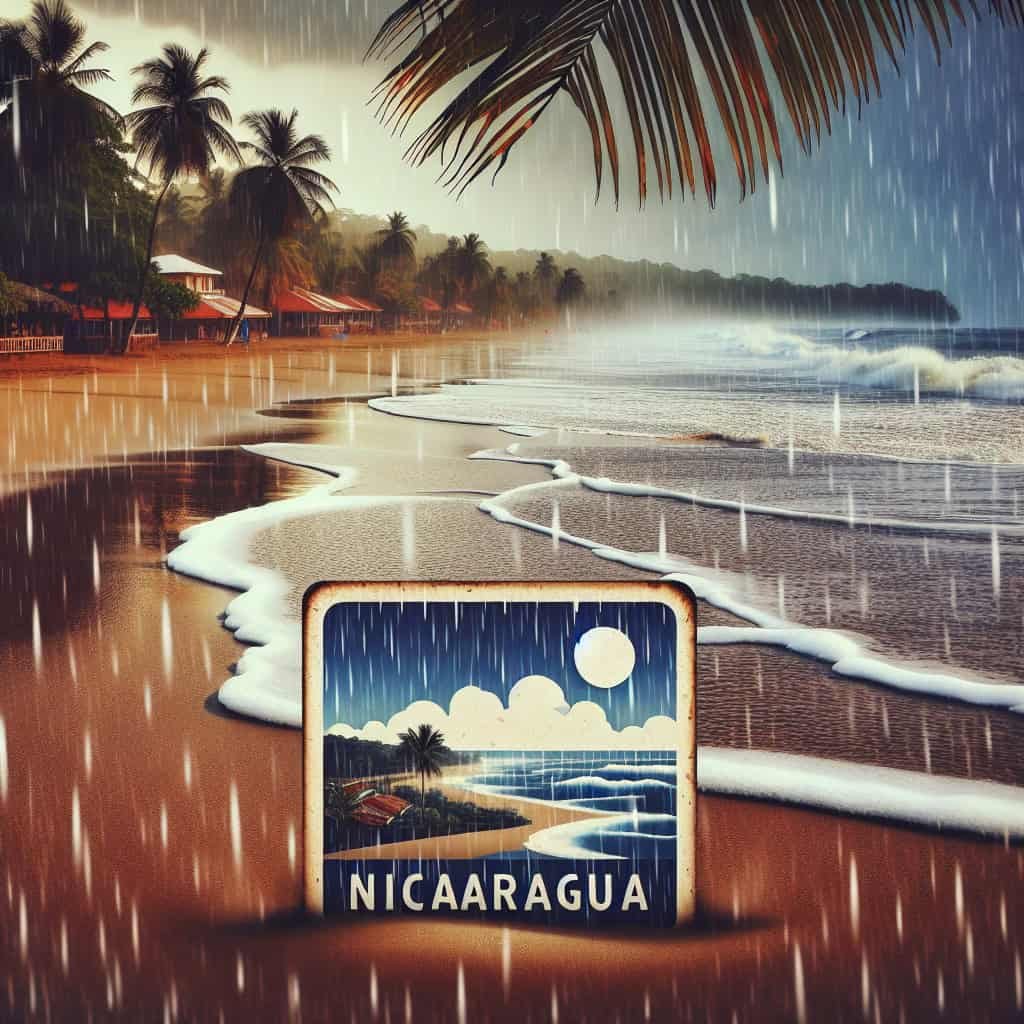Are you curious about what the beach conditions are like during the rainy season in Nicaragua? Look no further! In this article, we will take a closer look at what you can expect when visiting the beautiful beaches of Nicaragua during the rainy season. From the weather patterns to the waves and everything in between, we have you covered. So grab your sunscreen and get ready to discover the fascinating world of Nicaragua’s beaches during the rainy season!

Factors Affecting Beach Conditions
When it comes to the beach conditions during the rainy season in Nicaragua, there are several factors that play a significant role. Rainfall, tides, wind, and temperature all contribute to the overall state of the beaches. Each of these factors has its own unique impact on the beach environment, affecting everything from water quality to recreational activities. Understanding how these factors interact and influence beach conditions is crucial for both locals and visitors alike.
Rainfall
Rainfall is a vital aspect to consider when evaluating beach conditions during the rainy season. The amount and frequency of rainfall can greatly influence various elements of the beach ecosystem.
Amount of Rainfall
The quantity of rainfall directly affects the water levels at the beach. Heavy rainfall can cause water to accumulate, potentially leading to flooding and less desirable swimming conditions. On the other hand, moderate rainfall can help replenish the sand and create a pleasant environment for beachgoers.
Frequency of Rainfall
The frequency of rainfall is another essential factor. Regular rainfall can have an impact on the overall quality of the beach experience. Excessive rainfall may result in muddy waters, reducing water visibility and making swimming less enjoyable. Conversely, sporadic rainfall can bring relief from the scorching heat and create a more refreshing atmosphere.
Impact on Water Quality
Rainfall can significantly impact the quality of the water at the beach. Heavy rainfall can cause runoff, carrying pollutants and contaminants into the ocean, potentially compromising water quality. Visitors should remain cautious and check for any water quality advisories before venturing into the water.
Impact on Sand Quality
The quality of the sand is also influenced by rainfall. Heavy downpours can lead to erosion, washing away the sand and leaving behind a rocky or uneven shoreline. Conversely, moderate rainfall can contribute to the deposition of new sand particles, creating a smoother and more enjoyable beach experience.
Tides
Tides, a result of gravitational forces between the Earth, moon, and sun, have a significant impact on beach conditions during the rainy season in Nicaragua.
High Tide
During high tide, the water level rises, reducing the available beach area. The width of the beach may decrease, limiting space for sunbathing and beach sports. High tides can also influence swimming conditions, with strong currents and deeper waters present.
Low Tide
Conversely, during low tide, the water level recedes, resulting in a wider beach area. Visitors can take advantage of the additional space for sunbathing or engaging in various beach activities. Swimming conditions tend to be more favorable during low tide, as the water is shallower and currents are generally calmer.
Impact on Beach Width
The variation in tide levels directly impacts the width of the beach. Visitors should be mindful of the tide schedule to maximize their beach experience. Timing beach visits during low tide offers more room to relax and enjoy recreational activities.
Impact on Swimming Conditions
Tides play a significant role in swimming conditions. During high tide, stronger currents and deeper waters can pose challenges for swimmers. It is important to exercise caution and only swim within designated areas during these periods. Conversely, low tide provides a more favorable environment for swimming, with shallower and calmer waters.
Wind
Wind is another crucial factor to consider when evaluating beach conditions during the rainy season in Nicaragua.
Direction and Strength of Wind
The direction and strength of the wind greatly influence the beach environment. Offshore winds, blowing from land to sea, tend to create calmer waters and pleasant beach conditions. Onshore winds, blowing from the sea towards the land, can result in choppier waters and potentially impact various beach activities.
Impact on Wave Conditions
Wind plays a significant role in determining wave conditions. Strong winds can generate larger waves, creating ideal conditions for surfing and other water sports. Alternatively, gentle breezes can result in smaller waves, making swimming and other water activities more enjoyable for beginners or those seeking a more relaxing experience.
Impact on Beach Erosion
The strength of the wind also affects beach erosion. High-speed winds can accelerate the erosion process, resulting in the loss of sand and, in extreme cases, the destabilization of the beach. It is crucial to implement effective beach conservation strategies to mitigate the impact of wind-induced erosion.
Impact on Water Visibility
The wind can impact water visibility at the beach. When strong winds stir up the ocean, sediment and debris can become suspended in the water, reducing visibility. This can affect snorkeling or diving enthusiasts who rely on clear waters for optimal underwater exploration.

Temperature
Temperature plays a vital role in beach conditions during the rainy season in Nicaragua.
Air Temperature
The air temperature greatly affects the overall beach experience. During the rainy season, temperatures tend to be slightly cooler than in the dry season, providing relief from the intense heat. The pleasant air temperature creates a comfortable environment for beachgoers to enjoy various activities.
Water Temperature
The temperature of the water is another significant factor to consider. While rainfall can affect water temperature to some extent, it generally remains warm and inviting throughout the rainy season. This allows visitors to fully enjoy water-based activities, such as swimming or snorkeling, without feeling uncomfortable due to cold water temperatures.
Impact on Beach Activities
The temperature, both in the air and water, directly impacts the feasibility and enjoyment of beach activities. The cooler air temperature during the rainy season makes engaging in physical activities or lounging on the beach more pleasant. Visitors can enjoy beach sports, sunbathing, or simply taking a leisurely stroll along the shoreline without being overwhelmed by intense heat.
Impact on Tourist Visits
Temperature plays a significant role in determining tourist visits to the beach during the rainy season. The relief from scorching temperatures often attracts visitors looking for a more comfortable and enjoyable holiday experience. The pleasant weather conditions draw tourists to the beach, contributing to local economies and promoting tourism in the area.
Water Quality
Water quality is crucial for beach conditions during the rainy season in Nicaragua.
Runoff and Pollution
Heavy rainfall can result in runoff, carrying pollutants from various sources into the ocean. This can lead to reduced water quality, making it unsafe for swimming or other water activities. Visitors should pay attention to any water quality advisories or signs and avoid entering the water if there have been recent heavy rainfalls.
Algae Growth
Rainfall can also directly influence the growth of algae in the water. Certain types of algae thrive in nutrient-rich environments, which can be released into the water during heavy rainfalls. While some algae are harmless, others can pose risks to human health and affect the overall quality of the beach experience.
Impact on Swimmability
Water quality, affected by rainfall, directly affects the swimmability of the beach. If the water is contaminated due to runoff or excessive algae growth, swimming may not be recommended. Visitors need to remain informed about the current water quality conditions to ensure a safe and enjoyable beach experience.
Effect on Marine Life
Heavy rainfall and subsequent runoff can have a detrimental impact on marine life. Pollution and changes in water quality can harm local ecosystems, affecting the biodiversity and overall health of the marine environment. Conservation efforts are crucial to mitigate these effects and preserve the natural beauty of the beach.

Sand Quality
The quality of the sand is an essential component when evaluating beach conditions during the rainy season in Nicaragua.
Erosion
Rainfall, especially during heavy downpours, can lead to erosion of the sand. The force of the rainwater can wash away large quantities of sand, potentially leaving behind a rocky or uneven shoreline. Beach management practices should be implemented to minimize erosion and maintain a desirable sandy beach environment.
Deposition
Conversely, moderate rainfall can contribute to the deposition of new sand particles. This process can help replenish the beach and create a more appealing environment for beachgoers. The deposition of sand plays an important role in maintaining a stable and enjoyable beach experience.
Impact on Beach Stability
The quality of the sand directly impacts the stability of the beach. Erosion caused by heavy rainfall can result in an unstable beach environment, potentially compromising the safety and functionality of the beach. Consistent monitoring and preservation efforts are essential to ensure beach stability.
Effect on Recreational Activities
The quality of the sand has a direct impact on recreational activities at the beach. Smooth and fine sand is ideal for activities like building sandcastles, beach volleyball, or simply walking barefoot along the shore. Visitors tend to prefer beaches with high-quality sand, making it an essential factor in determining beach conditions.
Beach Width
The width of the beach is an important aspect when assessing beach conditions during the rainy season in Nicaragua.
Tidal Variation
Tides, influenced by the position of the moon and sun, directly impact the width of the beach. During high tide, the water levels rise, reducing the available beach area. Conversely, during low tide, the beach width increases, offering more space for recreational activities.
Impact on Sunbathing Areas
The variation in beach width affects the availability of sunbathing areas. During low tide, visitors have a wider beach area to choose from, providing more options to find a comfortable spot for sunbathing. High tide, on the other hand, limits the available beach space, potentially making it more challenging to find a suitable spot.
Effect on Beach Sports
The width of the beach is also crucial for various beach sports. A wider beach area during low tide allows for more extensive beach volleyball or soccer games. The availability of space directly influences the feasibility and enjoyment of beach sports, making it a significant factor for beach conditions.

Wave Conditions
Wave conditions greatly impact the overall beach experience during the rainy season in Nicaragua.
Wave Height
The height of the waves is primarily influenced by wind strength and direction. During the rainy season, when winds can be stronger, wave heights tend to be more significant. This attracts surfers looking for challenging waves to ride. However, for those seeking a more relaxed beach experience, smaller wave heights during calmer conditions may be preferable.
Wave Frequency
The frequency of waves relates to the time interval between each wave. The rainy season in Nicaragua can bring more frequent waves due to wind patterns. Surfers can take advantage of the increased wave frequency, providing more opportunities for great rides. However, others engaging in water activities may prefer less frequent waves for a more tranquil experience.
Impact on Surfing
Wave conditions greatly impact surfing opportunities during the rainy season. Surfers seek destinations known for consistent waves. Nicaragua, with its various coastal areas, attracts surfing enthusiasts due to its favorable wave conditions. The combination of wind, tides, and rainfall influences the quality and consistency of waves, providing excellent surfing opportunities.
Effect on Water Activities
Wave conditions affect the feasibility and enjoyment of various water activities. Calm wave conditions are ideal for snorkeling, stand-up paddleboarding, or kayaking, allowing for smooth and peaceful explorations. Conversely, more significant wave heights may attract thrill-seekers interested in experiences like bodyboarding or jet skiing.
Conclusion
Overall Evaluation of Beach Conditions during Rainy Season in Nicaragua
Taking into account the factors discussed, beach conditions during the rainy season in Nicaragua can vary significantly. The amount and frequency of rainfall, tides, wind patterns, and temperature all contribute to the overall beach experience. While heavy rainfall and higher waves may attract surfers seeking excitement, other visitors may prefer moderate rainfall, calm waters, and wider beach areas for relaxation and tranquil activities. Considering personal preferences and safety, visitors can make informed decisions on when and where to visit the beach during the rainy season.
Recommendations for Visitors
If planning a trip to the beach during the rainy season in Nicaragua, there are a few recommendations to ensure a pleasant and safe experience. Stay updated on weather forecasts and pay attention to any water quality advisories. Opt for lower-risk water activities during periods of high rainfall or when wave conditions are more challenging. Take advantage of low tide for wider beach areas and calmer swimming conditions. Finally, remember the importance of beach conservation and partake in responsible actions to protect the natural beauty of the beach.
Importance of Beach Conservation
Understanding the factors affecting beach conditions during the rainy season highlights the importance of beach conservation efforts. Preserving the quality of the water, sand, and overall beach environment is vital for the enjoyment of both locals and visitors. Implementing strategies to minimize erosion, mitigate pollution, and maintain beach stability ensure the long-term sustainability of these natural resources. Everyone plays a role in beach conservation, whether it is through proper waste disposal, supporting local initiatives, or practicing responsible tourism. By working together, we can continue to enjoy the beauty of Nicaraguan beaches for years to come.

